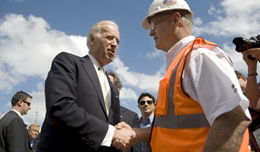Annual Report to the President
Annual Report to the President on Progress Implementing the American Recovery and Reinvestment Act of 2009
Download the entire report as PDF | Read Chapter 1 | Read Chapter 2 | Read Chapter 3
Vice President's Introduction
Dear Mr. President,
A year ago on February 17, 2009, Congress passed, and you signed, H.R. 1, the American Recovery and Reinvestment Act. In the three months prior to the Act, the nation lost 2.2 million jobs. Financial institutions were on the brink of collapse, and the “Great Recession” was being recognized for what it was – the most calamitous economic downturn since the Great Depression. You asked me to lead the implementation of the Act, with a focus on getting its efforts underway quickly, watching the taxpayers’ funds carefully, and putting America back to work. Attached is a report on the first year of our implementation efforts.
One year after the passage of the Act, we can report that approximately 2 million jobs have been created or saved thanks to the Act’s impact on hiring in the private sector, by local and state governments and by non-profits. This estimate comes from the Congressional Budget Office and is corroborated by the analysis of the Council of Economic Advisers. In January, we received more than 160,000 reports on progress from recipients of funds under the Act. These reports provided a transparent look at what was going on in projects and activities that accounted for a sample representing about 20 percent of overall spending under the Act.
To date, I have spoken to governors of all 50 states and local officials from over 130 jurisdictions. These state and local officials – both Democrats and Republicans -- have widely acknowledged the critical role that the Recovery Act has played in preventing teacher layoffs and avoiding tax increases.
By design, the Act had three primary purposes: Rescue, Recovery and Reinvestment. The enclosed report reviews our progress in each of these three areas. Almost 20 million Americans have gotten extended unemployment benefits thanks to the Act, and over 95 percent of working families have had their taxes cut. Jobs have been created thanks to tens of thousands of projects now underway nationwide. And the groundwork for the economy of the next century is being put in place as we invest in high speed rail, health technology, broadband, a smarter electrical grid, clean cars and batteries, and renewable energy.
Our work is far from finished. Many projects are just now getting underway, and will be creating jobs throughout 2010 and beyond. Today, we are announcing an additional $1.5 billion of innovative surface transportation projects that will support jobs and economic growth from coast to coast. Work on many Recovery Act projects will accelerate in the spring and summer months as weather conditions permit work on roads, bridges, water projects, and Superfund site clean ups.
Predictions at the outset of the Recovery Act warned of the potential for wide spread fraud. To combat this, Congress and the Administration put in place mechanisms to deter this fraud, including enhanced project reviews by agencies and the Office of Management and Budget, oversight of all spending and contracts by a team of 12 Inspectors General who make up the Recovery Accountability and Transparency Board, and focused work by the Justice Department’s Anti-Fraud Task Force on ‘Recovery Act activities. While any waste or fraud is unacceptable, the record to date compares very favorably with both public and private sector experience.
At the same time, we have been diligent in getting the funding into the hands of those who are creating jobs. Through the end of January, we have given tax cuts and obligated funds totaling $453 billion. We are on target to meet the Administration’s commitment that 70 percent of the funds will have been outlayed and delivered in tax benefits by September 30, 2010 – indeed we are ahead of schedule in meeting that goal.
The work that you set us out to do a year ago is going well. Projects underway thus far range from clean energy programs to highway improvement projects, from new health care facilities to investments in the nation’s “smart grid.” These successes have been the product of work by the 28 agencies who received Recovery Act funds. I meet with the heads of the major cabinet agencies regularly and can report that they have been engaged and responsive. The excellent work of the various White House staff is the glue holding together the network of federal agencies, and is essential to our progress.
I want to thank you for the confidence you showed in giving me this important task and I believe that we have served the American people well.
Cordially,
Joe Biden
THE RECOVERY BILL
The American Recovery and Reinvestment Act is a strategic and significant investment in our country’s future. The Act will save and create jobs immediately while also laying the foundation for a robust and sustainable 21st century economy by modernizing our health care, improving our schools, modernizing our infrastructure, and investing in the clean energy technologies of the future.

